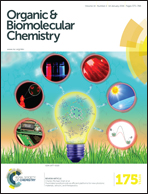DNA bases ring-expanded with a cyclopentadiene free radical: a theoretical investigation of building blocks with diradical character†
Abstract
In this work, we computationally design radical nucleobases which possess improved electronic properties, especially diradical properties through introducing a cyclopentadiene radical. We predict that the detailed electromagnetic features of base assemblies are based on the orientation of the extra five-membered cyclopentadiene ring. Broken symmetry DFT calculations take into account the relevant structures and properties. Our results reveal that both the radicalized DNA bases and the base pairs formed when they combine with their counterparts remain stable and display larger spin delocalization. The mode of embedding the cyclopentadiene free radical in the structures has some influence on the degree of π-conjugation, which results in various diradical characteristics. Single-layered radical base pairs all have an open-shell singlet ground state, but the energy difference between singlet and triplet is not significant. For two-layered radical base pairs, the situation is more complex. All of them have an open-shell state as their ground state, including an open-shell singlet state and an open-shell triplet state. That is, the majority of radical base pairs possess anti-ferromagnetic or ferromagnetic characteristics. We present here a more in-depth discussion and analyses to study the magnetic characteristics of radical bases and base pairs. As an important factor, two-layered radical base pairs also have been carefully analyzed. We hope that all the measurements and results presented here will stimulate further detailed insights into the related mechanisms in modified DNA bases and the design of better ring-expanded DNA magnetic materials.


 Please wait while we load your content...
Please wait while we load your content...